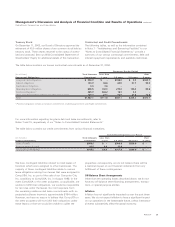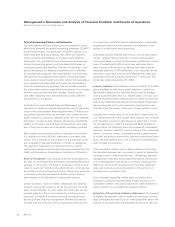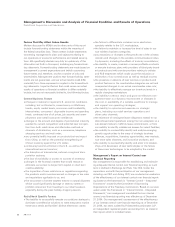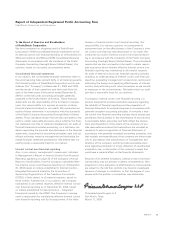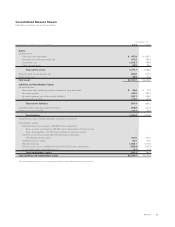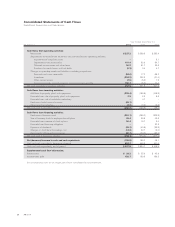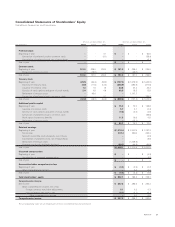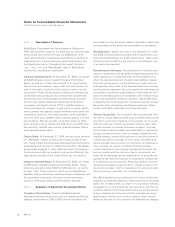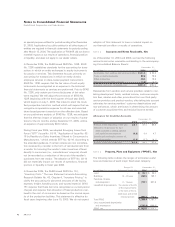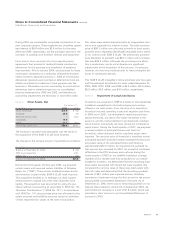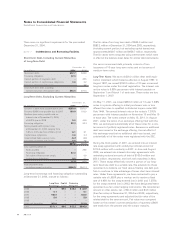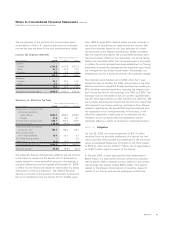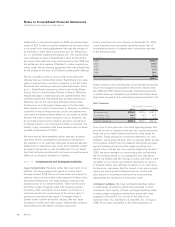Radio Shack 2004 Annual Report Download - page 40
Download and view the complete annual report
Please find page 40 of the 2004 Radio Shack annual report below. You can navigate through the pages in the report by either clicking on the pages listed below, or by using the keyword search tool below to find specific information within the annual report.
Notes to Consolidated Financial Statements
RadioShack Corporation and Subsidiaries
38 AR2004
NOTE 1 Description of Business
RadioShack Corporation was incorporated in Delaware in
1967. We primarily engage in the retail sale of consumer elec-
tronic goods and services through our RadioShack store
chain. Our strategy is to dominate cost-effective solutions to
meet everyone’s routine electronics needs and families’ dis-
tinct electronics wants. Throughout this report, the terms
“our,” “we,” “us” and “RadioShack” refer to RadioShack
Corporation, including its subsidiaries.
Company-Operated Stores: At December 31, 2004, we operat-
ed 5,046 company stores located throughout the United
States, as well as in Puerto Rico and the U.S. Virgin Islands.
These stores are located in major malls and strip centers, as
well as individual storefronts. Each location carries a broad
assortment of both private label and third-party branded con-
sumer electronics products. Our product lines include wire-
less phones and communication devices such as scanners
and two-way radios; residential telephones, DVD players,
computers and direct-to-home (“DTH”) satellite systems;
home entertainment, wireless, imaging and computer acces-
sories; general and special purpose batteries; wire, cable and
connectivity products; and digital cameras, radio-controlled
cars and other toys, satellite radios, memory players and well-
ness products. We also provide consumers access to third-
party services such as cellular and PCS phone and DTH satel-
lite activation, satellite radio service, prepaid wireless airtime
and extended service plans.
Dealer Outlets: At December 31, 2004, we also had a network
of 1,788 dealer outlets, including 45 located outside of the
U.S. These outlets provide private label and third-party brand-
ed products and services to smaller communities. The dealers
are generally engaged in other retail operations and augment
their businesses with our products and service offerings. Our
sales derived outside of the United States are not material.
Company-Operated Kiosks: At December 31, 2004, we operat-
ed 599 kiosks located throughout the United States. These
kiosks are primarily inside SAM’S CLUB locations, as well as
in major malls. These locations, which are not RadioShack-
branded, offer product lines including wireless telephones and
the associated accessories. We also provide consumers
access to third-party cellular and PCS phone services.
NOTE 2 Summary of Significant Accounting Policies
Principles of Consolidation: The Consolidated Financial
Statements include our accounts and our majority-owned sub-
sidiaries. Investments in 20% to 50% owned companies are
accounted for using the equity method. Significant intercompa-
ny transactions and accounts are eliminated in consolidation.
Reclassifications: Certain amounts in the December 31, 2003
and 2002, financial statements have been reclassified to con-
form with the December 31, 2004, presentation. These reclas-
sifications had no effect on net income or stockholders’ equi-
ty as previously reported.
Pervasiveness of Estimates: The preparation of financial state-
ments in conformity with generally accepted accounting prin-
ciples requires us to make estimates and assumptions that
affect the reported amounts of assets and liabilities, related
revenues and expenses, and the disclosure of gain and loss
contingencies at the date of the financial statements and dur-
ing the periods presented. Our most significant estimates and
assumptions include the determination of estimates for third-
party service deactivations in connection with revenue recog-
nition and receivables, inventory valuation, depreciable lives
of property, plant and equipment, insurance reserves, intangi-
ble assets, and contingency and litigation reserves. Actual
results could differ materially from those estimates.
Revenue Recognition: Our revenue is derived principally from
the sale of private label and third-party branded products and
services to consumers. Revenue is recognized, net of an esti-
mate for customer refunds and product returns, when deliv-
ery has occurred or services have been rendered, the sales
price is fixed or determinable, and collectibility is reasonably
assured. Certain products, such as wireless telephones and
satellite systems, require the customer to use the services of
a third-party service provider. In most cases, the third-party
service provider pays us a fee or commission for obtaining a
new customer, as well as a monthly recurring residual
amount based upon the ongoing arrangement between the
service provider and the customer. Fee or commission rev-
enue, net of estimated service deactivations, is generally rec-
ognized at the time the customer is accepted as a subscriber
of a third-party service provider. Recurring residual income is
recognized as earned under the terms of each contract with
the service provider, which is typically as the service provider
bills its customer, generally on a monthly basis.
We offer extended service contracts in all states in which we
operate, but retain the liability for these contracts in only three
states. For all other states, our share of commission revenue is
recognized as income at the time the contract is sold. For the
contracts offered in the three states where we are the primary
obligor, revenues from the sale of these contracts are recog-
nized ratably over the terms of the contracts. Costs directly
related to the sale of such contracts are deferred and charged



